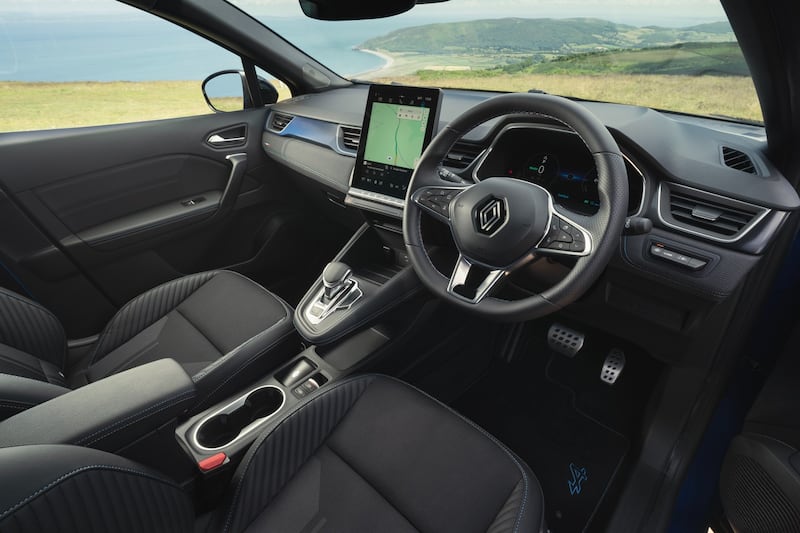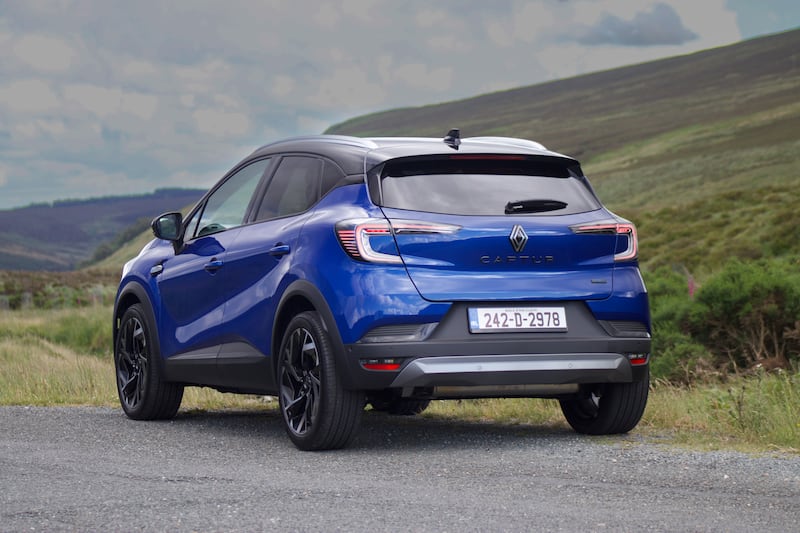If you had asked me before today if I had driven the current Renault Captur, to be honest I’d have struggled to give you a definitive answer. I know I had driven a Captur, possibly a couple of them, but to be frank I think most of the experience had slipped from my mind.
This time around, though, the Captur is making a bit more of an impression. Renault has given its compact crossover a thorough pass of the plastic surgeon’s scalpel, so while it’s not totally different, it is at least … better.
At the front, Renault has taken away the soft curves that it originally gave the Captur and has instead given it sharper lines, with prominent arrowhead daytime running lights (which are supposed to represent one half of the Renault diamond badge) and a look that’s slightly reminiscent of the bigger Scenic all-electric SUV. It’s a broadly successful look, helped by the deep Alpine Blue paintwork of our test car, even if a quick glance down the sides tells you instantly that behind the rhinoplasty this is the same car as before.

The interior has been given a makeover too. While the overall shapes are familiar, the quality of the materials used has taken a definite step upwards, which makes the Captur’s cabin a far more welcoming and less physically wobbly place to be now. This Esprit Alpine model’s use of soft, suede-like material and a smattering of French flags brings a touch of Bastille Day glamour to things. Space in the back is fine, if nothing special, while the boot is good, a claimed 616 litres. You have to have the adjustable rear seats slid all the way forward to get that much cargo space, making them useless to any occupants with legs, but there’s still a useful 480 litres of boot volume with the seats pushed all the way back.
READ MORE
The biggest improvement is the big, upright touchscreen in the centre of the dashboard. Even the base Captur now gets this new 10.4-inch screen, which optionally comes with Google-based software which Renault claims is a first within this segment of the market. It’s a fantastically slick system – just log in with your own Google details, and all of your saved destinations are right there in the mapping system, which can also be displayed – full screen – in the optional 10-inch digital instrument panel (a seven-inch digital instrument screen is standard).
What makes this system so good is that Renault has included proper physical controls for the heating and air conditioning system – although disappointingly our high-spec Esprit Alpine model didn’t include two-zone climate control, which seems cheapskating for a car costing close to €40,000.
Renault has also included one critical button – a one-touch switch (yes, a proper physical switch) which allows you to instantly silence the annoying beeps and bongs so common to modern cars, and which frankly are a bigger danger – through distraction – than any of the things they’re warning about.
You can have the updated Captur with a totally decent 90hp 1.0-litre three-cylinder turbo petrol engine, but our car came with the 145hp 1.6-litre hybrid, which drives the front wheels via an insanely complex automatic gearbox which uses four physical gears and two electric motors to achieve almost infinite gearing. I’ve seen a Lego model of this gearbox, and spoken to one of the engineers who created it, and I still don’t quite fully understand how it works.
However, it does work, and although it never feels quite as smooth as Toyota’s e-CVT hybrid gearbox, it works relatively well. Occasionally the 1.6 engine revs out of sync with what you’re doing with the pedals, but other than that it’s a fairly good system.
It’s economical too, returning an average of 5.5 litres per 100km during our time with the car, in spite of some high-speed motorway cruising. I’d expect an equivalent Toyota Yaris Cross to return more like 5.0 litres per 100km in the same circumstances, but there’s not much in it really, and the Renault has a more welcoming cabin.

In terms of how it drives, Renault says that it has given the Captur “a range of high-tech developments to increase driving pleasure.” Which means that it has retuned the suspension, and fiddled with the power steering. The result is good. Not brilliant, and certainly not rewarding enough to really cash the cheques signed by those Alpine badges scattered about the place (to drive the Alpine A110 sports car is to experience some serious driving fun) but the Captur, having previously had such as dull driving experience that it was a danger to insomniacs, has now become fairly pleasant and unremarkably decent.
No one is going to buy a Captur for the illicit pleasure of an early-morning back-road drive, but it’s economical, decent to look at, composed to drive and has a very comfortable cabin. While that’s not perhaps a ringing endorsement, it does at least mean that the Captur has now reached a level which means I won’t forget it as soon as it’s gone.
Lowdown: Renault Captur E-Tech hybrid Esprit Alpine
Power: 1.6-litre four-cylinder petrol engine with 105kW e-motor and 1.2kWh lithium-ion battery producing 145hp and 205Nm of torque and powering the front wheels via an automatic transmission.
CO2 emissions (annual motor tax) 105g/km (€180).
Fuel consumption: 4.7l/100km (WLTP)
0-100km/h: 10.6 secs.
Price: €39,815 as tested, Captur starts from €29,120
Our rating: 3/5.
Verdict: The updated Captur drives better, looks nicer and is impressively economical. This time, we won’t forget it. Honest.













